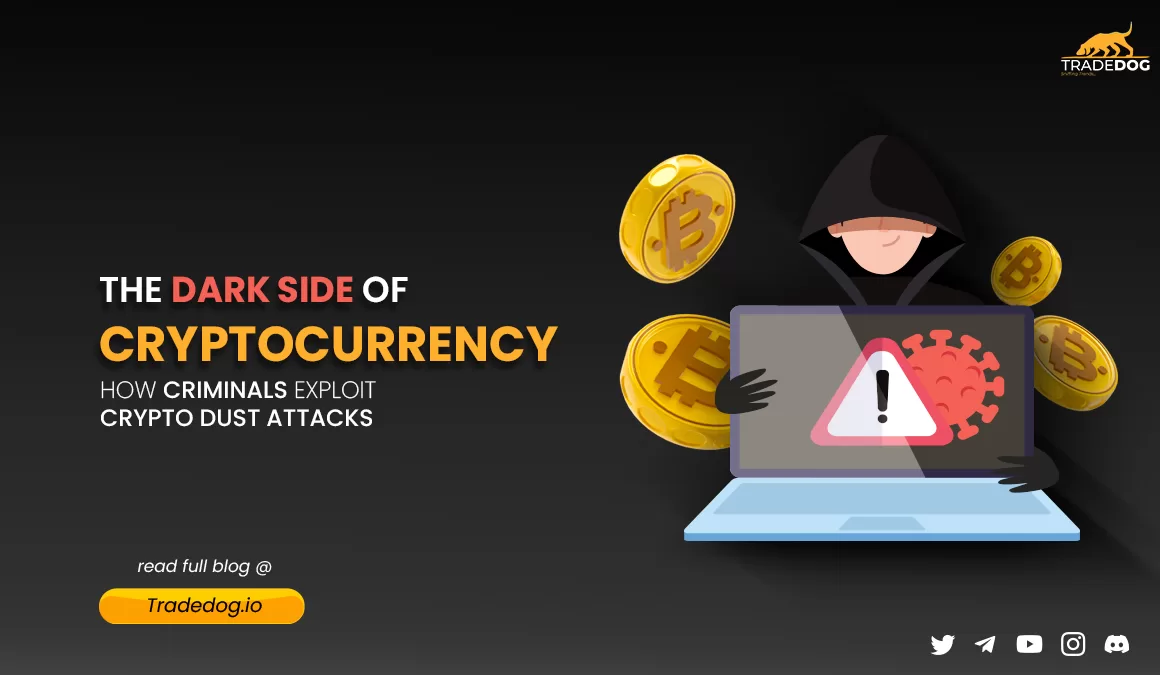Quick Links
Crypto dust refers to the small amount of cryptocurrencies like Bitcoin, Litecoin, Dash and others in a wallet. It is called dust because the amount is too tiny or not valuable enough to come to a user’s notice. It is generally an amount equal to or lower than the transaction fees. Anyone who actively trades or transacts in cryptocurrency will probably have dust in their wallet. These dust balances are not tradeable but can be converted into the exchanges’ native tokens.
What is a Crypto Dust Attack?
A dusting attack is a type of cyberattack where dust is transferred to multiple wallet addresses by malicious actors intending to identify the owner of these wallets by tracking their transactional activities and then targeting them with phishing scams or cyber extortion threat. Dusting will not allow hackers to steal cryptocurrency. Still, it will enable them to invade the user’s privacy by analyzing the movement of funds from one address to another.
Are all Dusting Activities crypto scams?
Crypto Dusts are transferred to wallet addresses for hacking and multiple purposes. It is a technique governments use to identify criminal activities like money laundering and tax evasion and ensure regulatory compliance. It can be used to conduct stress tests to determine the robustness of the software by sending large amounts of dust to check the bandwidth and throughput of a network. Moreover, it can also be used to spread a message by adding a message in the crypto dust, like in the case of the Genesis block of Bitcoin (the first block ever mined included a message).
What is a Dusting Limit?
It refers to the minimum number of tokens one must hold to transact or transfer. For instance, just like $1 equals 100 cents, similarly in the case of Bitcoin, a unit of Bitcoin (BTC) is equivalent to 100 million satoshis. The dusting limit set by Bitcoin Core (Bitcoin blockchain software) is around 546 satoshis. Any transaction equal to or smaller than 546 satoshis or 0.000000546 BTC will be automatically rejected by validating nodes. The dust limit is usually based on market conditions such as token price and transaction fees.
How does a Crypto Dust Attack work?
Blockchain technology allows the user’s identity to be anonymous. Still, the transactions are transparent, and anyone can track the movement of funds which helps them unmask the owner’s identity. Also, such attacks are common in Unspent Transaction Output (UTXO) blockchains like Bitcoin, Bitcoin Cash, and Litecoin. UTXO prevents double spending and is the remaining cryptocurrency balance in a wallet after a particular transaction is executed, similar to the change we receive from a vendor when we pay a $5 note for a bill amounting to $3.5.
Let’s say you currently hold 1 BTC in your wallet and must disburse a payment of 0.35 BTC. As discussed earlier, the minimum holdings required to transact is 0.000000546 BTC. In this case, you hold a sufficient amount to make the payment and the transaction fees of 0.00007225 BTC ($2.183) as of the recording date. This 1 BTC is considered as the input. The transaction will create two UTXO outputs: one of 0.35 BTC, sent to the recipient’s address. The other remaining balance minus the transaction fee comes to around 0.64992775 BTC. It is sent back to your address as a change.
Users who engage in one or more transactions may have multiple such UTXOs in their wallet, and the amounts are so small that a user cannot track these figures. The attackers use this to distribute crypto dust among hundreds or thousands of users. The user unknowingly claims the dust and includes other funds in the same wallet.
The output generated allows hackers to track back the inputs of previous transactions, creating a trail of the transaction history. Analyzing the record makes it possible to identify patterns of behavior and link transactions to specific users or entities.
Risks of Crypto Dust Attacks
The execution of crypto dust attacks poses privacy and security risk as it helps attackers to deanonymize users and trick them into phishing sites to drain their funds. With the expanding use cases of DeFi and NFT, users are attracted to projects offering free airdrops of cryptocurrency. Unable to differentiate between authentic and illegitimate sites, users connect their wallets to these sites, which enables attackers to steal their funds. It can cause network congestion as miners need to process a large number of transactions, which also increases transaction fees.
In 2020, a dusting attack was carried out against Binance, where the attackers sent small amounts of BNB to multiple addresses. Once a user claimed the dusted fund in his transactions, he received a transaction memo with a link to a malicious website to trick him into clicking it and getting hacked unknowingly.
How to protect yourself against Crypto Dust Attacks?
An increase in the dusting limit and transaction fees has made it expensive for attackers to launch an attack. Yet, users must be aware of how to protect themselves from these malware practices to ensure the privacy and the safety of their funds:
- Most of the exchanges allow users to swap crypto dust with their native tokens, which will help them to identify random crypto dust in their wallets quickly.
- The users can create an HD wallet (hierarchical deterministic wallet) which enables them to create a new address for every transaction and prevent attackers from tracking the transaction history.
- Users can use VPN (a virtual private network) or The Onion Router (TOR) to strengthen their security.
Some measures can also be adopted by exchanges or wallets, like a real-time dusting attack alert to prevent a user from falling into the trap of using the dusted funds. In late 2018, Samourai wallet developers issued a warning to their users of experiencing an attack. They asked to mark the particular UTXO as “Do not Spend”. Similarly, a notice was posted by Binance in 2019 when it observed an attack on one of the popular altcoins – Litecoin.
As the nature of public blockchain allows anyone to access transaction records, it raises concerns about deanonymization. 90% of cryptocurrency users prefer centralized exchanges requiring KYC, making tracing their identity easier. This can disturb users who prioritize privacy. In such scenarios, coin mixers or tumblers come into play, protecting the user’s identity.
What is Coin Mixing?
Coin Mixing refers to a service provided by a third party where an individual transacting through cryptocurrency can keep his identity anonymous by sending his crypto holdings to the third party, who mixes it with his reserves and other users’ funds and resends the same amount of crypto holdings to the wallet address given by the depositor. This jumbling of funds makes it challenging for outsiders to track transaction history and protects users’ anonymity. Third-party providers typically charge a 1-3% fee for their services, which they deduct before returning the mixed funds to the user.
Use Cases of Coin Mixing
Although the primary intention behind coin mixing is to safeguard the financial privacy of its users, it has unfortunately become a preferred tool for money laundering among crypto criminals. According to a recent report by Chainalysis, the percentage of illicit addresses utilizing mixers has surged from 10% in 2021 to 24% in 2022. Consequently, the Office of Foreign Assets Control (OFAC) of the United States Treasury Department has imposed sanctions on prominent mixers, such as Blender.io and Tornado Cash, for their involvement in laundering stolen cryptocurrency.
Conclusion
Both Crypto Dusts and Coin Mixers offer unique benefits and drawbacks to users who utilize them, and it is crucial for individuals to carefully evaluate the potential risks and rewards before deciding to engage with these tools. While Crypto Dusts can provide a simple way to accumulate small amounts of cryptocurrency over time, they also carry the risk of being left unused or forgotten, potentially leaving users vulnerable to security breaches or hacks. Similarly, Coin Mixers can offer enhanced privacy and anonymity when conducting transactions, but they can also be associated with illicit activities and may attract unwanted attention from regulatory bodies.









